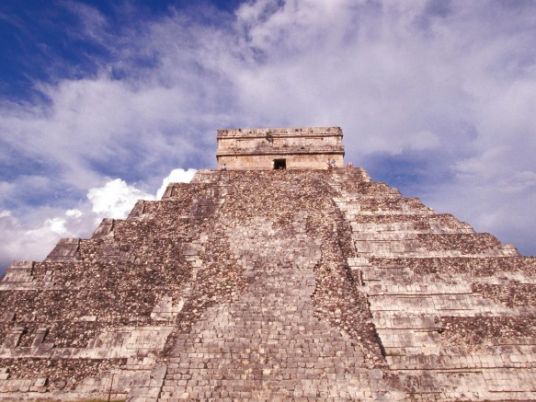
Scientists have found a second pyramid hidden deep within the Kukulkan pyramid at the Mayan ruins of Chichen Itza in Mexico.
Researchers announced the discovery Wednesday of a pyramid 10 meters tall (33 feet) inside two other structures that make up the pyramid also known as El Castillo, or the Castle.
Earlier excavations in the 1930s had already revealed one structure inside the pyramid containing a red jaguar throne studded with jade.
Chichen Itza was founded about the sixth century, presumably by the Maya peoples of the Yucatán Peninsula. There is evidence of a 10th-century invasion by foreigners, probably Mayan speakers strongly influenced by the Toltec of central Mexico.
The invaders were responsible for the construction of El Castillo, which rises 24 meters (79 feet) high. It is constructed on top of a body of water known as a cenote, formed by a sinkhole in limestone formations.
A legendary tradition at Chichen Itza was the cult of the cenote involving human sacrifice to the rain god.

New tomography undertaken by researchers found another pyramid deep inside the Kukulkan pyramid.
Using a noninvasive imaging technique, researchers were able to look inside and discover a second substructure below the first one.
A ramp was observed — most likely a small stairway — and the probable existence of a religious altar.
"The structure that we have found, the new structure, is not completely in the center of the Kukulkan pyramid. It is in the direction where the cenote is," said Rene Chavez Segura, a scientist at the National Autonomous University of Mexico, or UNAM.
"This could either confirm or hypothesize that the Mayans when they built this structure that they knew of the existence of this cenote."
Insight into how settlement developed
The recent field work in the area, completed in 2015-16, determined that the most important habitation period of Chichen Itza was divided into three eras: that of 550 to 800, corresponding to the era of "pure Mayas"; from 800 to 1000, a transitional period, when pilgrims from the center of Mexico arrived and began the Maya-Tolteca style; and a final stage of occupation from 1000 to 1300.
The structure discovered in the 1930s corresponded to the transitional period, and the one found now is from the pure Mayan style, according to the research team from the Geophysics Institute of UNAM's Engineering School and the National Institute of Anthropology and History.
"If this could be investigated in the future, this structure would be significant because it would speak to the first few periods of habitation of the site and would provide information about how the settlement developed," said Denisse Argote from the National Institute of Anthropology and History.
"With the discovery of this structure we're talking about something from the pure Mayans. A lot has been excavated, and there is a lot of information on the transitional periods (of the Mayas) and there is a Mexican style at the site, but there is little information on the original site," she added.
Argote described the ruins as sacred, cosmic locations where "the governors, the priests were in contact with the spiritual world."
The research team developed the noninvasive imaging technology — tri-dimensional electric resistivity tomography — used to make the discovery of the second substructure, and it's new within the geophysics field, according to Chavez Segura.




